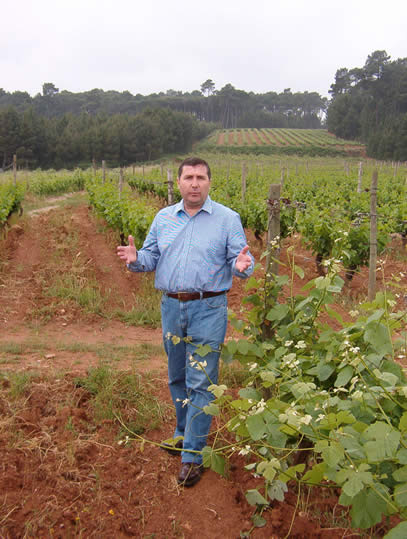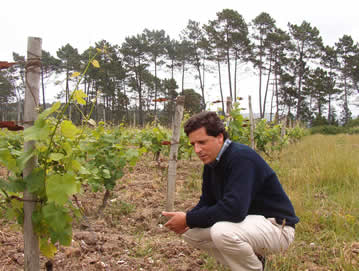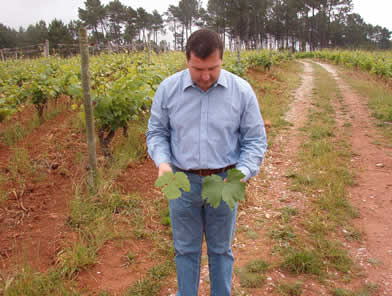|
Spotlight
on Portugal's Dão region
Part
2: Quinta dos Roques/das Maias
| Quinta dos Roques, at Abrunhosa do Mato
(between Nelas and Mangualade) was the starting point in my visit to Dão.
It’s a family owned company, and I was met by the owner and general
manager, Luís Lourenço, and consultant winemaker Rui Reguinga.
It used to be the tradition in the Dão to have red and
white grapes interplanted in the same vineyard. People liked light-coloured
wines, and the combination of white and red grapes helped to achieve
this. From 1978 onwards the vineyards at Dos Roques were replanted and
in 1990 the first wines were produced bearing the Quinta’s name.
Altogether there are 40 hectares of vines here.
|

Luis in the vineyard - 'the
bunch was this big' |

Rui Reguinga admiring
some young vines in a pine-fringed vineyard typical of the
Dão |
In 1997 they bought out another Dão Quinta, Das Maias, and
now own 94% of this – the wines from this estate had already been
made at Dos Roques since 1992. Das Maias is a 35 hectare property at a
higher altitude in the foothills of the Serra da Estrela. They control
both companies but bottle the wines separately to preserve their
different identities.
Rui Reguinga began work here in May 2002, and has taken the
quality – which was already very good – up a notch. He knows the
vineyards well and has been separating the grapes from the different
blocks of vines more in the winery.
|
| Green harvest is now more
thorough, and the quantities of the top wines have dropped since he
has been in charge.
The soils at Dos Roques are mostly granitic sand, with
small quantities of schist and clay. 40 hectares of vines are split
between 12 different vineyards. The 1400 mm annual rainfall figure
quoted by Luís is more than double that of London, but most of it
falls during the winter, although there's an ever present risk of rain
at harvest time. The altitude of the vineyards is around 450
m, which is quite high (das Maias is even higher at 600 m). Vine age
is from 5–25 years.
I spent quite a bit of time wandering around the vineyards
– I always find visiting vineyards a lot more instructive and
enjoyable than looking at stainless steel fermentation tanks, barrel
rooms and bottling lines.
|

A change of terroir mid-row,
from sandy granitic (foreground) to granite with clay (rear) |
| The different varieties look quite
different, even at this fairly early stage in their growth cycle.
Touriga Nacional shows a distinctive, wild growth habit with shoots
sticking out at all angles. Jaen has small leaves and a lovely
light-green hue. Tinta Cao has huge dark green leaves. The vineyards
at Dos Roques are quite modern, employing cane pruning and vertical
canopy growth. Quite a few vines have been grafted across to the more
successful varieties.
|

Luis holding leaves of
Jaen (left) and Tinta Cao (right) |
I like the Dos Roques/das Maias wines a great deal. The quality is high
overall: the reds are modern, dark and self-assured, but with a degree
of elegance too. The whites are clean and fresh, but not lacking in
personality.
On to the wines...
Back to top
|




